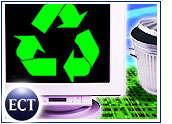
Did you hit any garage sales when you were growing up? Most likely you didn’t do it to save the planet but rather to make money or shop for bargains. Regardless of the motivation, a secondary result — one with far grander, long-term benefits — is that a lot of old items sold were kept out of the trash.
When yard sales and the want ads went online thanks to eBay, selling was taken up to the next level; however, as before, the environmental impact of the model took a “back seat” benefit to the sale of quirky, hard-to-find items and a new breed of online entrepreneurs.
So, what have we learned from eBay? Why did it fail to fully embrace the opportunity to impact the environment? How have newer e-commerce models succeeded in making the environment a priority and creating a call to action from consumers?
The Allure of Power-Selling
Founded in 1995, eBay was one of Internet’s first true success stories. eBay’s recipe for success is easy to grasp: It gave sellers the opportunity to sell off old, unwanted goods and buyers the chance to easily scour the thousands of items listed — anything from a Pez dispenser to a bicycle — all from the convenience of their home. eBay legitimized the Web’s ability to act as a marketplace through which people could sell virtually anything.
So why didn’t eBay really embrace the green side of its business? The truth is that eBay’s rapid accession to the position of Internet “poster child” took its sights off becoming the online recycling king. Instead, it focused on the sale of quirky items and then the almighty PowerSeller.
Power-selling turned eBay into big business, leaving individuals on the outside. The good news is that sites like eBay opened the industry’s eyes to the possibilities this medium had to offer. Its foundation spawned a new generation of e-commerce models, some focused on joining the ranks of Internet giants and others on helping more and more people take the road less traveled: the green road.
The question now is: How is this new breed succeeding in getting consumers to act? First off, they have committed to the cause. Second, they realize that old habits die hard and that for many, tossing the old phone into the trash is the only way. This realization that you are battling a deeply seeded behavioral pattern is just the first step. Accepting the fact that action is going to take more than a Web site comes next. At this time, two key themes come into play: education and incentivization.
Supporting Education
Consumers need to learn that if they toss their laptop into the garbage there are ramifications. In other words, while the old laptop or cell phone is out of your sight and your mind, it has not been erased altogether. There are environmental side effects that must be considered.
Just consider the following facts:
- The average North American gets a new cell phone every 18 to 24 months.
- Currently, the average American throws the equivalent of two laptops, three iPods and three cell phones into a landfill each year, equaling 2,124,000 tons of waste (see ewasteguide.info), annually creating 65,000 tons of waste, according to the Environmental Protection Agency.
- Items such as laptops and cell phones contain mercury, cadmium and lead, just to name a few potentially hazardous materials.
In addition to an environmentally focused education, there is a value-based lesson as well — not family values, but rather value as in an item’s worth. The fact is that while your old laptop might be worthless to you, it is not worthless. These gadgets are built to last, so your old device still holds tremendous value. For the seller, that value could be put towards the purchase of a newer item. For the buyer, the value is the item itself.
Take the automobile as an example. How often do parents buy their children a used “starter” car? When money is an issue, starting with a used car makes more sense. To make it happen, you scour the online and offline classifieds to find a car that meets your needs.
Now take this example into the world of consumer electronics. Say Person A bought the new iPod and is not sure what to do with the older device. The easiest thing to do is toss it into the garbage. At the same time, Person B is looking to dive into digital music waters but is looking to do so at a lower price tag. For this person, a used iPod fits the bill. It comes back to value: The old iPod has value to Person B who is willing to take it off Person A’s hands for a small fee. The end result? The device stays in circulation and the seller makes a buck or two.
The Incentive
Understanding environmental consequences and inherent secondhand item value are one thing; call to action is another. Most people know when they toss an old camera into the trash that it could instead be recycled. These same people also know that if they took the time they could most likely find another person that would take the item off their hands.
The problem? This requires they take a few extra steps, which is where the action gets stalled. Many people are not motivated to take this step even when they are educated to the consequences. The e-commerce sites of today that are succeeding are doing so because they have found ways to “incentivize” sellers to take action.
We are not talking about the instilling a feeling of good will. That model only works for a select few. The incentive is threefold. First, it must be easy. Perhaps the biggest roadblock to getting somebody to change their behavior is making it so easy that they cannot pass it up. Second, it must be fast.
This is where many sites fall short. For example, putting an item up for auction on eBay is far from easy. The seller has to create a description of the item, determine the asking price, take a picture and upload it to the site, field a never ending slew of questions from perspective buyers, await the payment (which sometimes never arrives), package the item and then go to the post office and send it off. The post office alone can be a nightmare. For a PowerSeller, this is their job so time and commitment is not an issue. For the rest, free time is in short supply and ultimately they are dissuaded from moving forward.
Do the Right Thing
Newer sites remove these hurdles in favor of a “sell-it-now” model, which eliminates the auction in favor of a trade-in scenario that then introduces the final and most powerful incentive of all: money. With sites that combine both ease, speed and commerce, sellers can go online and look up their item, see what its worth — generally based on available third-party market data — and then arrange for the shipper to come to your home or place of work to pick it up. The process can literally be completed in minutes with guaranteed payment coming a few days later.
Compare this to older models, which can take weeks to conclude and in the end offer no guarantee that the final price is what you want it to be. Where is the incentive there? That’s right: There isn’t one.
The sites of today have grabbed the seller’s attention. Now that old phone destined for the trash can find its way into the hands of another — all for a small fee. Getting people to do the right thing is possible.
Rousseau Aurelien is founder and CEO of Second Rotation, an online destination for people to sell consumer electronics and gadgets.















































To add to your point, you can turn in your old iPod when buying your new one, and receive 10% off. When asked where the iPods go after I turn them in, the Apple cashier said "an iPod cemetary in Cupertino." The scary thing is, that probably exists!